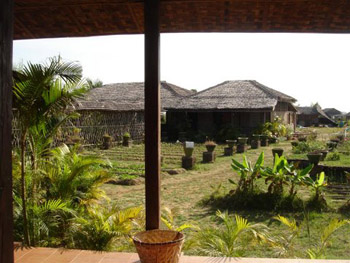
Myanmar
by Mark Tippet
EDITOR’S NOTE: This is a first-hand account of the devastating cyclone that has taken thousands of lives in Myanmar. Mark and Yeon Tippet are a dedicated couple who operate several orphanage/schools at Weiyone Seik. Yeon also has a program for building wells. One well provides enough water for an entire village so even small donations can go a long way.
May 8, 2008
We are both in the land of the living, and despite all the drama of being hit by a cyclone, spirits are high, and we have got the house back into shape, and to a large extent damage from hundreds of fallen trees around the Estate has been largely cleared away, and the golf course will reopen for play on Saturday, one week after the storm.
Yeon was fortunately in Hong Kong decorating. I was here with several of our staff, and we battled the storm throughout the night, clearing crashing plants and smashing pots, and fighting to clear the drains as water gushed through the house as they blocked on the upper verandas.
When dawn broke, the gardens were a spectacle of utter devastation: royal palms chopped in half; bougainvillea trellises collapsed into the swimming pool; hundreds of ridge tiles shooting off the roofs and crashing into the pool and as far as the lake. The lake itself appeared through the dawn like an ocean, with waves streaking across it as the cyclone circled overhead, and swept down again and again to ground level.
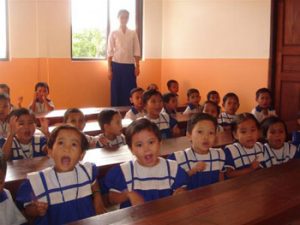 The noise in the house as the cyclone whirled around was deafening, and the upper landing glassed in roof seemed on the point of flying off at every gust of wind hit the house. Around nine am there was a lull and then we entered the eye of the storm. The rain was streaming down, but I decided to venture outside and see how far I could get standing upright – Taking a small Sony CyberShot wrapped in towels and a Ziploc bag to protect it from the rain, wearing a bicycle helmet for protection against flying debris, I opened the front door of the house.
The noise in the house as the cyclone whirled around was deafening, and the upper landing glassed in roof seemed on the point of flying off at every gust of wind hit the house. Around nine am there was a lull and then we entered the eye of the storm. The rain was streaming down, but I decided to venture outside and see how far I could get standing upright – Taking a small Sony CyberShot wrapped in towels and a Ziploc bag to protect it from the rain, wearing a bicycle helmet for protection against flying debris, I opened the front door of the house.
Despite what we had been through during the night, the spectacle of devastation outside was still beyond anything I could have imagined – Pots and plants smashed up against the house entrance; 60 foot giant Burmese wabo bamboos ripped out of the ground, and my much-loved Royal Palms lopped in half or bent at crazy angles, the driveway invisible under a coating of shredded palm-fronds, bamboo leaves, smashed roofing and other storm detritus.
I got near the main gate and saw it was nothing to the drama outside our property in the rest of Tamarind Gardens: a “lake” two and half feet deep as far as I could see – No road visible, lamp stands flattened, and all the large Tamarind and Padauk trees crashed down into the “river” flowing between all the properties .
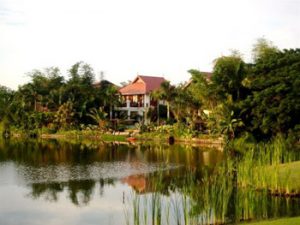 Nothing was moving outside – No people, no dogs, no anybody. On the basis that the water depth was no more than two and half feet, I I fired up my trusted Land-Rover, selected low-gear ratio, and eased out into the water.
Nothing was moving outside – No people, no dogs, no anybody. On the basis that the water depth was no more than two and half feet, I I fired up my trusted Land-Rover, selected low-gear ratio, and eased out into the water.
Driving up Tamarind Gardens was an obstacle course of navigating fallen trees. Sometimes I just powered through them, and occasionally I drove up on the pathway and squeezed between the uprooted stumps and houses fencing. All the time the wind noise came and went, while I drove with one hand, and filmed and photographed Pun Hlaing’s unimaginable new landscape.
After two attempts, I finally navigated out of Tamarind Gardens into Bougainvillea Drive, where the waters were much deeper, but with fewer trees lining the roads, I was able to drive with two wheels up on the pathways, raising the engine above water level. I went past the Project Office – metal roofs ripped away – past the workshops: no roof left – past SPA Design with its banana-leaf thatched roofs: unrecognizable – past the Golf Apartments (where I saw a guard racing through the rain from his hut into the main building, the only human being I saw anywhere) – up to the main roundabout at the lake in front of Serge’s house, still inching forward in two to three feet of water – and round towards the Club. Finally, half-way down towards Jasmine Gardens, which was the first area we developed pre-opening in 2000, and so where the largest and oldest trees are, I could go no further, blocked by four massive rain trees from both sides of the wide road, making it totally impassable.
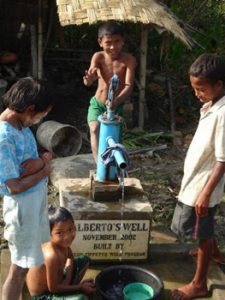 I reversed round, and headed up to the main gate, between the majestic toddy-palms on Pun Hlaing Entrance Avenue past the hospital – Right across the road at the main entrance turn-in to Pun Hlaing, a large uprooted tree totally blocked access to the Estate, so we were truly marooned from the outside world. Little did I think at the time that Pun Hlaing would be an oasis of “normality” from the rest of the city as the true scale of the devastation dawned.
I reversed round, and headed up to the main gate, between the majestic toddy-palms on Pun Hlaing Entrance Avenue past the hospital – Right across the road at the main entrance turn-in to Pun Hlaing, a large uprooted tree totally blocked access to the Estate, so we were truly marooned from the outside world. Little did I think at the time that Pun Hlaing would be an oasis of “normality” from the rest of the city as the true scale of the devastation dawned.
Turning back to home, the L-R plugged its way through the eerie desolation of an Estate without people, without lights, and looking unlike it had ever looked before . Turning into Tamarind Gardens, I could not believe that I had actually driven out of the morass of uprooted trees and river of water which I saw right to the bend in the distance. The wind started to get stronger again, so I pushed on back through the debris, and finally reached the home, just as I blew a rear tire on the Land-Rover, which must have been punctured by a sheared off branch or other unseen debris below water-level. An hour and a half after leaving the house I made it to the portico, to be greeted by an anxious staff.
The storm raged on until the afternoon, and some six hours later people began to emerge from their homes for the first time, and the waters gradually receded, the full impact of the cyclone apparent as the massive roots of uprooted trees rose up out of the water.
Main Government power went down along with the thousands of snapped power line poles, so we lost our newly built million dollar 33 KVA transformer station during the night, but our other Estate generators had automatically cut-in to keep power going. These our engineers cut-off when the storm had ripped holes in the Aluzinc roofs of all our substations, one by one, and the electrics cut-out at Pun Hlaing for the first time since we opened on 8th. October 2000. So, we were without power, and cut off from the outside.
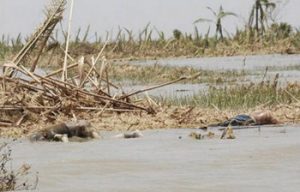 By Saturday night we got the inside of the house back to a semblance of normality, and had dinner by candlelight cooked on gas. On Sunday our Estate staff and residents’ house staff along with my gardeners who lived in the villages beside Pun Hlaing, began sawing up the trees along Tamarind Gardens, and by the end of the day, a road was breached though the debris, which cars could go down.
By Saturday night we got the inside of the house back to a semblance of normality, and had dinner by candlelight cooked on gas. On Sunday our Estate staff and residents’ house staff along with my gardeners who lived in the villages beside Pun Hlaing, began sawing up the trees along Tamarind Gardens, and by the end of the day, a road was breached though the debris, which cars could go down.
I had eight people on our verandah for lunch on Sunday. I had food and staff, and they were in Evergreen without power, staff or much food. The sun came out, and a few bottles of Chardonnay made the world seem a better place . In the afternoon we tried to cross the River to our orphanage, but the waves were too high.
We got across the next morning, to a totally wiped out community – 56 homes around our orphanage, and hundreds more in the rest of Waiyone Seik, and only three left standing. Our orphanage, being a well-built brick and iron-wood frame structures, were the only buildings left standing and fully intact. We moved all three hundred of the villagers, from young babies to a 92 year old woman into the orphanage. Our eight Heidi’s nest children we moved into our adjoining building where the classrooms are.
Our new kitchens which Yeon had just built are a blessing – even though part of the Aluzinc roof was holed by the storm – as we now feed all the village, and they live inside the orphanage main building. When Yeon got back by plane from Hong Kong after the airport opened, she agreed to continue to feed the villagers for as long as it takes us to rebuild their homes, provided we can procure enough rice and cooking oil supplies, and of course fresh drinking water.
Spirits are very high, and the villagers are completely in our care, and I think they are the luckiest along the whole Pun Hlaing River, after what I witnessed when I explored the river in our motor boat with Mongton and Jewel after the storm. Our boat is one of the few undamaged boats on that part of the river, as our boatman had ridden out the cyclone on board to keep it from pitching up onto the river bank.
All the way up the river were sights of tragic devastation, with bamboo thatched-roofed homes crushed flat or simply swept away. Our villagers are now almost the only ones with a secure roof over their heads, and two meals a day!
Pun Hlaing and Mayon are miraculously back to normality, unlike the city, and unlike the Irrawaddy Delta. Whatever CNN and BBC report, they can have no concept of the losses in the Delta – Yeon and I went down there after the Tsunami, and we cannot believe that ANYONE we helped three years ago can possible have survived, as the whole point of the Delta is below water level. The mouth of the Delta is a Continental Shelf, and when storms come in, the force of the sea builds up in the shallows as it rides up the Shelf, and this is why the satellite pictures now show the whole area below water – I was with a naval captain this morning, who believed the water levels in the area at the mouth of the Delta must exceed 20 feet.
NOTE: Recent reports estimate the number of deaths from the cyclone as over 100,000, with thousands more expected to die from disease, and lack of food, water and medical help.
To Donate To The Disaster Fund Check These Websites:
Khom Loy Development Foundation (UK)
www.justgiving.com
Metta Foundation (USA, Myanmar)
www.metta-myanmar.org
Save the Children Canada
www.thehumanitariancoalition.ca
Tear Australia (Australia)
www.tear.org.au
Justgiving (U.K.)
www.justgiving.com
Cassils Wettstein Asia Fund
www.cwasiafund.org


Leave a Reply
You must be logged in to post a comment.